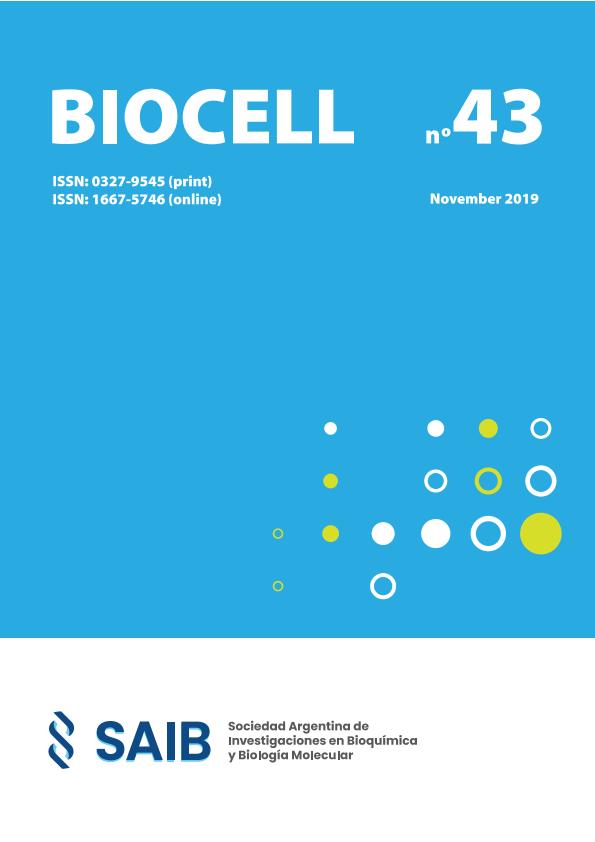Evento
Novel caffeine analogs as potential leaders on the cholinergic system
Fabiani, Camila ; Biscussi, Brunella
; Biscussi, Brunella ; Munafó, Juan Pablo
; Munafó, Juan Pablo ; Salvador, Gabriela Alejandra
; Salvador, Gabriela Alejandra ; Corradi, Jeremias
; Corradi, Jeremias ; Murray, Ana Paula
; Murray, Ana Paula ; Antollini, Silvia Susana
; Antollini, Silvia Susana
 ; Biscussi, Brunella
; Biscussi, Brunella ; Munafó, Juan Pablo
; Munafó, Juan Pablo ; Salvador, Gabriela Alejandra
; Salvador, Gabriela Alejandra ; Corradi, Jeremias
; Corradi, Jeremias ; Murray, Ana Paula
; Murray, Ana Paula ; Antollini, Silvia Susana
; Antollini, Silvia Susana
Tipo del evento:
Congreso
Nombre del evento:
Congreso de la Sociedad Argentina de Investigación Bioquímica
Fecha del evento:
05/11/2019
Institución Organizadora:
Sociedad Argentina de Investigación en Bioquímica y Biología Molecular;
Panamerican Association for Biochemistry and Molecular Biology;
Título de la revista:
Biocell
Editorial:
Sociedad Argentina de Investigación en Bioquímica y Biología Molecular
ISSN:
0327-9545
e-ISSN:
1669-9106
Idioma:
Inglés
Clasificación temática:
Resumen
Cholinergic deficit is regarded as an important factor responsible for Alzheimer’s disease symptoms. Two molecular targets for the treatment of this disease are acetylcholinesterase (AChE) and nicotinic receptor (nAChR). We previously demonstrated that caffeine has a dual effect on muscle and a7 nAChRs, behaving as a weak agonist at low concentrations and as a negative modulator at high concentrations. Furthermore, it is wellknown that caffeine also acts as an inhibitor of AChE. The aim of this work was to synthesize more potent caffeine analogs with a dual effect on the cholinergic system by inhibiting AChE and potentiating nAChRs. With this objective, a theophylline fragment, resembling the caffeine chemical structure, was connected with a pyrrole fragment, which is present in the nicotinic chemical structure, through homologation from 3 to 6 carbon atoms (Cn). We first tested the capacity of the different compounds to inhibit the AChE. We found that whether theophylline alone inhibited the enzyme, pyrrolidine did not. With respect to Cn, they all can inhibit the AChE at concentrations of 100, 200, and 400 µM, having C6 the strongest effect. We then explored if theophylline, pyrrolidine, and Cn influence the nAChR conformational state. To this end, we used the AChR conformational-sensitive fluorescence probe crystal violet (CrV) and AChR-rich membranes from Torpedo californica. We found that whether pyrrolidine induced changes in the KD values of CrV taking the nAChR to a state close to the desensitized one at concentrations of 200 and 400 µM, theophylline did not show a significant change in the KD value. The combined analogs also produced changes in the KD values of CrV. This effect was dependent on the length of homologation, being C5 and C6 the most potent analogs with effect at concentrations lower than 50 nM. To understand the molecular mechanism underlying the conformational changes of the nAChR, we expressed adult muscle nAChR in HEK293 cells and performed single-channel recordings with different Cn concentrations. We found that C5 activated muscle nAChR at very low concentrations (from 0.01 pM). At the highest tested concentration (30 µM), we observed a decrease in the mean open duration, which suggests that C5 also acts as an open channel blocker. As a partial conclusion, we can say that we have synthesized more potent caffeine analogs through the combination of caffeine and nicotinic structures. The effect of theophylline on AChE, the effect of pyrrole on AChR, and the effect of Cn on both proteins suggest different pharmacophore profiles for these target molecules. Our results bring new information about the mechanism of modulation of pharmacologic targets for the design of new therapies for the intervention in neurological diseases.
Archivos asociados
Licencia
Identificadores
Colecciones
Eventos(INIBIBB)
Eventos de INST.DE INVEST.BIOQUIMICAS BAHIA BLANCA (I)
Eventos de INST.DE INVEST.BIOQUIMICAS BAHIA BLANCA (I)
Eventos(INQUISUR)
Eventos de INST.DE QUIMICA DEL SUR
Eventos de INST.DE QUIMICA DEL SUR
Citación
Novel caffeine analogs as potential leaders on the cholinergic system; Congreso de la Sociedad Argentina de Investigación Bioquímica; Salta; Argentina; 2019; 78-79
Compartir



